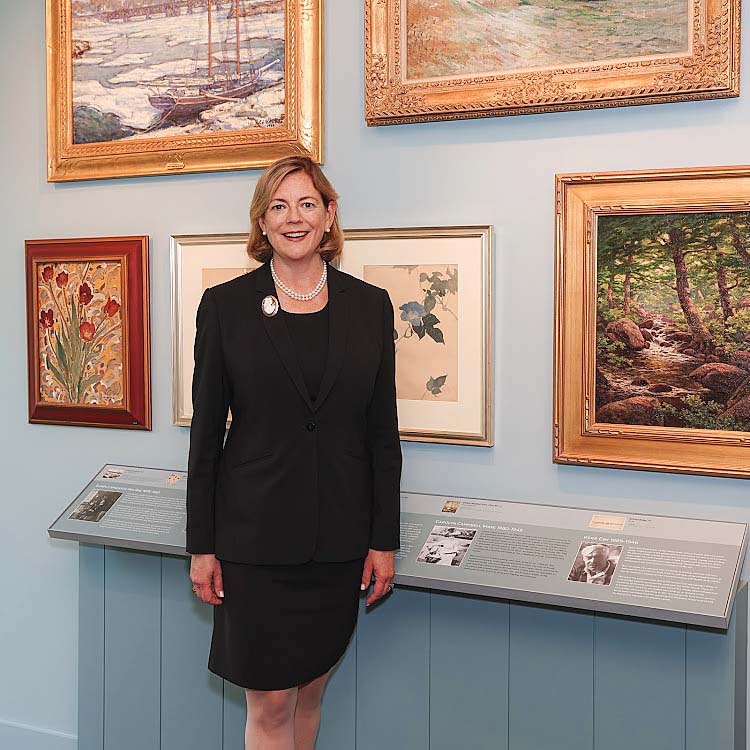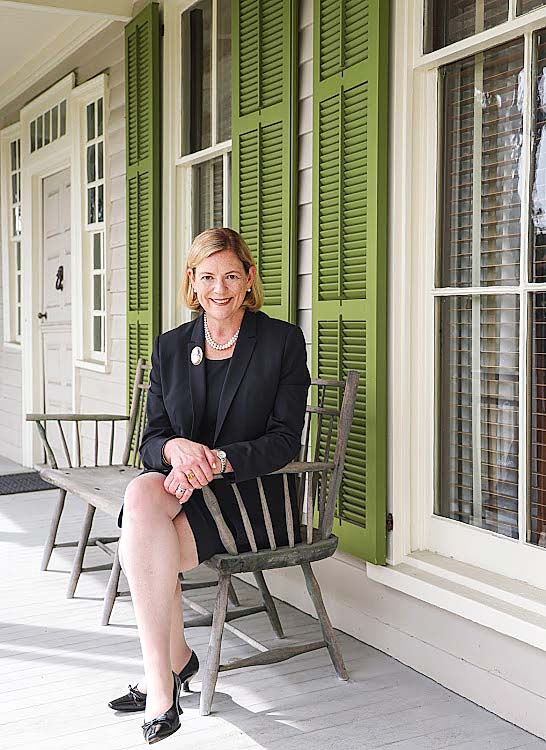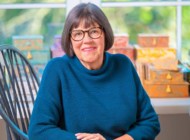
Cadou in the Permanent Collections Gallery. Bob Capazzo Photography.
Carol B. Cadou has been named the new executive director and CEO of Greenwich Historical Society. Previously, she had leadership roles with The National Society of Colonial Dames of America (NSCDA), Winterthur Museum and George Washington’s Mount Vernon. About a month into the position, we got in touch with her to see how the transition is going and to learn more about Greenwich Historical Society’s future with her at the helm.
Congratulations on the new role with Greenwich Historical Society! How has it been so far, and how has it been an adjustment compared to your previous roles?
Greenwich Historical Society has all the elements of a Mount Vernon or Winterthur — the historic house, collection of fine and decorative arts, library and archives and gardens. However, unlike my previous institutions, the property and collections tell a broader story than one great man or one place. The Bush-Holley House speaks of a colonial family who did not take a side during the Revolutionary War, were deemed to be Loyalists by many and saw their economic and social positions suffer as a result. It also allows us a window into the transformation of a once thriving commercial waterfront community to a vibrant immigrant community and aging Eighteenth and Nineteenth Century buildings that provided for the birth of American Impressionism at the Holley Boarding House. The former Post Office and Justus Luke Bush Storehouse building and the recently acquired Toby’s Tavern add depth to these stories and provide avenues to understand a range of inspiring moments in our nation’s history.
Did you have any connection to Greenwich prior to accepting this position?
Besides the occasional visit to Greenwich, I had no real connection to the town or Connecticut before arriving at the Historical Society. The mere size of Greenwich and its varied landscape have been a terrific surprise. You have the waterfront with its history of maritime trade and competitive sailing as well as the rolling rocky hills of the back country where architects like Carrère and Hastings, John Russell Pope and McKim, Mead and White built great estates. It’s both a beautiful and storied place.

Cadou on the Bush-Holley House porch. Photo by Cortney Wood.
What are some of your primary tasks as the executive director and CEO?
One of the tasks I am most looking forward to is defining a vision and future for the Historical Society as it enters its next stage of growth. Over the course of three decades, my predecessor grew the site to include additional historic buildings and state-of-the art modern facilities. It is now exciting to imagine how this campus and the expanding collections can be used to reach broad audiences in Greenwich and beyond.
What are you most excited about as you step into this role?
I have spent the bulk of my career in colonial and federal period America. My family teases me that my world stops with George Washington’s death in 1799. While our first president will always be a guiding star, I’m thrilled to rekindle my appreciation for the American Impressionists and the development of uniquely American artistic expressions in the late Nineteenth and Twentieth Centuries. It’s thrilling to stroll through the room where Childe Hassam spent his years painting at the Holley Boarding House and to see through the canvases how he and his fellow impressionists influenced one another at the dawn of modernism.
What changes can visitors to the Bush-Holley House, the Museum & Library and the Library & Archives expect going forward?
We are embarking on a winter project to introduce environmental control to the Bush-Holley House that will provide stabilizing conditions for its important collection of decorative arts and Impressionist works. Beginning this spring, visitors will benefit from more comfortable tours as well as a new interpretation of the house that includes a focus on Greenwich’s maritime history. The museum galleries will feature the third in a series of exhibitions inspired by America250, we are introducing guided gallery tours and will have behind the scenes opportunities with the Archivist.
As with many in historical fields, we’re looking ahead to the nation’s semiquincentennial. Does the Greenwich Historical Society have any associated celebrations in the works for this next year?
In addition to our America250 exhibitions and on-site programs, we are bringing the Dutch Tall Ship Oosterschelde to Greenwich Harbor for a once-in-a-generation opportunity to board and experience an historic vessel like those that sailed up and down our colonial coast. There will be ticketed special events aboard the Oosterschelde as well as one free day for the public on June 28 — the 250th anniversary of the day the Declaration of Independence was presented to the Second Continental Congress.
—Carly Timpson




